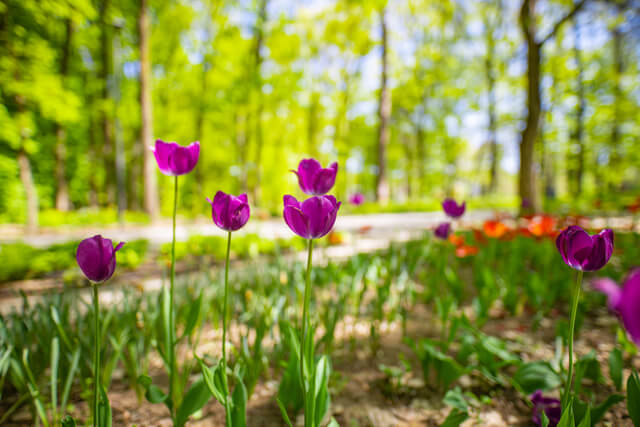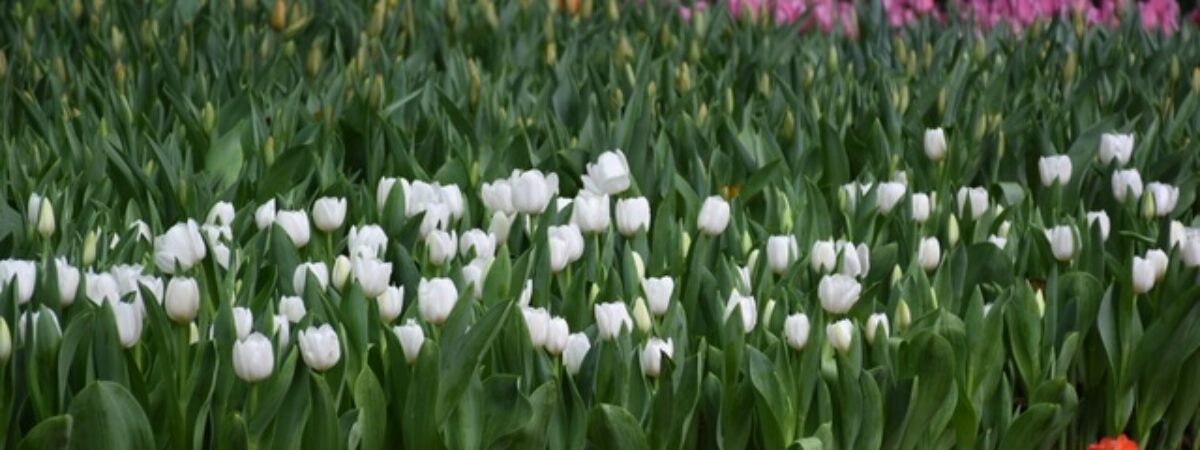If you want to grow an ornamental bulbous plant that can add beauty to your garden, the brightly colored jewels to brighten up your days, no doubt Tulip plants are the best option for you. No matter where you grow these plants, in a container, pot, prepared beds, or basins, these plants thrives well.
Belonging to the family of Liliaceae and genus Tulipa L, these plants are popular garden flowers famous for their appearance and can be grown in a greenhouse, playhouse, or in a shade net too. These plants generally emerge from the ground during early spring or late winter.
With a cup or egg-shaped flowers and around 6 petals, these plants are found in the colder regions in the shade of orange, pink, cherry, magenta, salmon, crimson, purple, apricot, lilac, mauve, blue, yellow, apricot, brown, violet, terracotta, red, scarlet, chocolate, etc that can paint your garden with wide pallets.
Although tulips are perennial plants technically, hybridizing these plants for many centuries demonstrates that the bulb’s ability to come back year after year has weakened. Click To TweetAlthough tulips are perennial plants technically, hybridizing these plants for many centuries demonstrates that the bulb’s ability to come back year after year has weakened. That’s why, many gardeners treat these plants as annuals, that plant new bulbs every autumn.
Like other plants in the Liliaceae family, tulips also contain alkaloids and glycosides contains and are harmful to humans. It is also too much toxic for the pets. if the bulbs are consumed wrongly, then it can cause skin rashes and other gastrointestinal problems.
These plants are native to the arid regions, especially in Central America.

Varieties of Tulips to grow
There are many varieties of tulips that grow throughout the world. There are thousands of different types of tulips spread over 15 official classifications based on flower shape, height, and time of bloom. There are generally three classes of this flower which include early flowering tulips, mid-season tulips, and late flowering tulips.
The main varieties of early flowering tulips include Duc Van Tol, Single early, double early, etc. the main varieties of mid-season tulips include Mendal and Triumph. Darwin, Darwin hybrids, Parrots, Double late, Rembrandt, and lily flowered are the main varieties of the late flowering tulips.
How to plant the tulips
Below is the planting guide for the tulips
- Plant the bulbs deeply in the ground- around 3-4 times the size of the bulb. Digging the soil deeper loosens the soil and allows for drainage.
- Set the bulb in the soil by making the pointy end up. Cover the hole with soil and press it firmly so that the bulbs get settled in the soil.
- Water the bulb after planting.
- Although bulbs are their own storage system and contain all the required nutrients in it they need, you can feed the plant with a balanced fertilizer, organic matter, manure, etc.
- Treat the plants from the pests and diseases.
Caring guide of tulip plants
Soil
Tulip plants are generally grown on slopes that have a good drainage system. Thus, tulip plants require light sandy loam soil that has a good drainage system for better growth. Planting these plants in the raised beds is also recommended if you don’t have proper knowledge about well-drained soil.
If you are growing the plant in heavy soil, then it is recommended to add some well-decomposed compost, peat moss, or other organic matter to ensure proper growth.
Tulips grow well in slightly acidic soil. So ensure that your soil has a pH of 6-7 if you are growing tulip plants in your garden.

Sun
Tulips don’t require any specified light to grow and they can be grown in full sun or partial shade. Direct sun is necessary in the morning and evening for the proper growth of flowers. Likewise, partial shade is required during the mid-day.
Temperature
Tulips can’t grow in hot climates and thus they require colder climates to grow. So the temperature should be 20-26 degrees centigrade during the day and 5-12 degrees centigrade during the night for proper growth.
in the regions of warm winter temperatures, this plant must be planted as annuals from suppliers who prechill the bulbs.
Tulips grow well in slightly acidic soil. So ensure that your soil has a pH of 6-7 if you are growing tulip plants in your garden. Click To TweetHumidity
The plants grow well in dry regions than the humid regions as high humidity goes hands-on hand with the spring and summer rain that can rot the bulbs.
Water
Water the plant properly right after planting the plant. Left it and don’t water the plant until the season drys out properly and the plant demands water. If your place is getting regular raining every one to two weeks, don’t water the plant at all. It is also recommended to water the plant every two weeks in the arid regions.
Fertilizer
Cow manure, compost, farmyard manure, bonemeal, granular fertilizer, and organic manures are the best organic fertilizer for the growth of tulip plants. The best inorganic fertilizers food the growth of the plant includes NPK 5-10-5.
The fertilizer should be added to the soil once during the time of planting, and once in the following spring when they tend to sprout again. Besides this, no additional need to fertilize the plant.
How do prepare land for tulip plants?
If you are planting the Tulip plant in a pot or in the ground, then it is necessary to prepare the land beforehand. You can prepare the land for tulips by getting the soil to a fine tilth stage and removing the weeds of the previous crop from the soil.
To ensure the proper growth of the plant, it is required to supplement the soil with garden compost or organic manure. It is recommended to prepare beds in case of poor drainage.
How to propagate tulip plants?
If you are looking to propagate tulip plants, they can be propagated by the bulbs and bulblets and sometimes from the seeds as well. However, it can produce different shades of flowers.
You can propagate the plant by lifting bulbs or by dividing the bulblets from the mother bulbs. This process is generally done in the fall during the normal planting time of the tulip plants.
Propagation can be done by digging up the bulb with a trowel or spade. Then brush off the soil and separate the small offset bulbs from the mother bulb. inspect the bulb properly and remove the soft or deformed bulbs from it.
Replant the offsets and the mother bulb. make sure the depth of the planting should be dependent on the size of the bulb. Tulip plants can be planted at 5 to 8 cm deep with a spacing of 15 cm apart in general.
Provide the plant with proper shading during mid-day for the longevity of the flowers.
After propagation, the plant will not produce flowers for one to two years. It will start flowering after the third year.

How do prune the tulip plants?
If you are growing the plant perennial, it is necessary to prune the plant. To prune the plant, remove the stalks of the flowers immediately after they start flowering to prevent the plants from producing seed pods, which drains the bulb’s energy and shortens its life.
To replenish the bulb’s energy, leave the foliage in its place until it starts yellowing in mid to late summers.
How to harvest Tulip bulbs and flowers?
Generally, Tulips start flowering from February to April. So the flowers can be harvested during this time. When it comes, to flower harvesting, the scapes can be cut along with two leaves when the color starts to develop in the flower petals.
If you want to harvest the bulbs, it can be done 45 days after flowering and when the leaves of the plant start turning yellow. During bulb harvesting, remove the bulb scales and roots. Air-dry the bulbs in partial shade and store them at 7-10 degrees centigrade for 7-8 weeks for the proper development of the flowers.
Common pests and diseases
Tulip plants are prone to attack by thrips and aphids which can be treated by the spraying of rigor, Endosulfan, Malathion, Aldicarbs, etc.
These plants are also very prone to infection by the fusarium and fungus which can be determined by the foul smell of the flowers and the appearance of white molds which is recommended to control by drenching Benomyl.
Conclusion
Like daffodils, tulips are the best plant for your garden that can add colors to it and enrich the garden with its beauty.
As you read this far of the article, you might get to know that the growing and caring guidance of the tulips is so simple and they are very easy to take care of.
So plant these perennial, beautiful plants in your garden and add some vibrant beauty to it.






